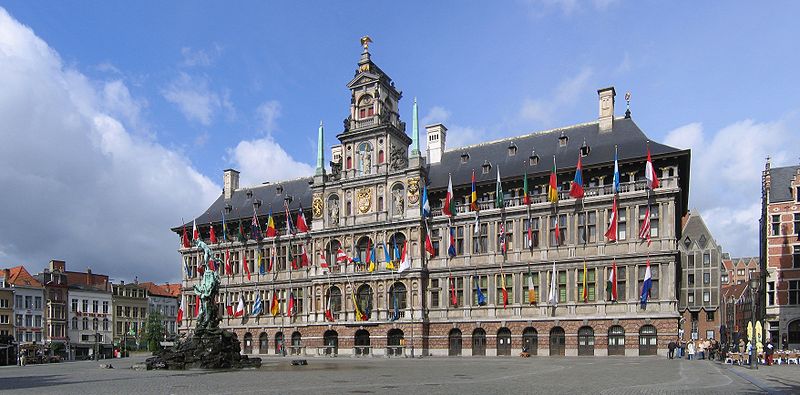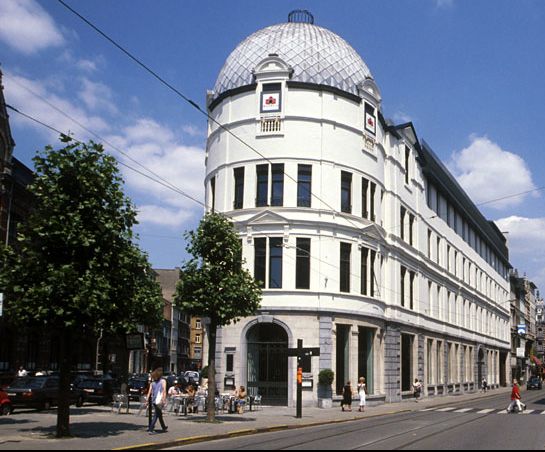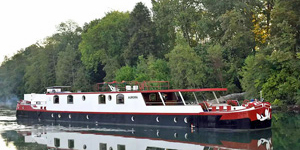Barging in Belgium
[ CHOCOLATE - ANTWERP - GHENT - BRUGES ]
BELGIUM... More than just chocolate ???

The Kingdom of Belgium is a country in northwest Europe bordered by the Netherlands, Germany, Luxembourg, France, and the North Sea. It covers an area of 30,528 square kilometres (11,787 sq mi) and has a population of about 10.7 million. Belgium is a parliamentary democracy under a constitutional monarch. It is a founding member of the European Union and hosts its headquarters, as well as those of other major international organizations, including NATO.
Geographically and culturally, Belgium is at a crossroads of Europe, and during the past 2,000 years has witnessed a constant ebb and flow of different races and cultures. Consequently, Belgium is one of Europe's true melting pots with Celtic, Roman, Germanic, French, Dutch, Spanish, and Austrian cultures having made an imprint.
Straddling the cultural boundary between Germanic and Latin Europe, Belgium is home to two main linguistic groups, the Flemish and the French-speakers, plus a small group of German-speakers. Belgium is made up of three regions: the Dutch-speaking region of Flanders in the north; the French-speaking southern region of Wallonia; and the Brussels-Capital Region, while officially bilingual, is a mostly French-speaking enclave within the Flemish Region. A small German-speaking community exists in eastern Wallonia. Belgium's linguistic diversity and related political and cultural conflicts are reflected in the political history and a complex system of government.

Did we mention CHOCOLATE???
Belgium produces 172,000 tons of chocolate per year with more than 2,000 chocolate shops throughout the country. Pralines in Belgium are sublime chocolate confections. A beautifully sculpted chocolate shell conceals a center of filling which explodes with a surprising texture and flavor in your mouth. Many chocolatiers still make their pralines by hand. Every town and even small villages have chocolate stores with luxurious pralines.
Every year at the beginning of May, Bruges is host to a world famous four-day chocolate festival where chocolatiers compete to see who can produce the world's best chocolate.
ANTWERP

Antwerp is the largest city in Flanders which is the northern part of Belgium, and is 48km (30 miles) north of Brussels and 51km (31 miles) northeast of Ghent. The Port of Antwerp is the second largest port in Europe, one of the ten largest ports worldwide and also the most productive. A dense network of rivers and canals, road and railways ensures an easy connection to other parts of Europe.
Home of the Flemish Baroque master Rubens, Antwerp not only has a wealth of outstanding museums, picturesque galleries, sculpted streets and beautiful architecture, but is also laced with refreshing greenery and urban haunts. The city boasts a magnificent cathedral, a fine-arts museum full of Flemish masterpieces, a maze of medieval streets in the town center, and a vibrant nightlife and cultural scene. Through the centuries the city has managed to develop a rich and unique, valuable cultural heritage. The city's museums and historic churches are treasuries in which many of these riches are preserved and on display.
- Diamond center
Antwerp has a long and magnificent tradition as a diamond city. The city has played an important role in the diamond industry since the 15th century. Antwerp, acknowledged as the "Diamond Center of the World," is the leading market for cut diamonds and second only to London as an outlet for raw and industrial diamonds. The diamond business is worth $23 billion a year, which trumps Amsterdam's $1 billion. "Antwerp quality" and "Antwerp cut" are international trade terms synonymous with perfect processing and flawless beauty.
Some 1,500 diamond companies are concentrated in the city center. In less than one square kilometer, nearby Central Station, more than half of all cut diamonds pass through a network of diamond cutting shops, diamond bourses and selling centers. Of the 25 diamond exchanges worldwide, four operate in Antwerp. Elegant showrooms offer the visitor fascinating tours and the opportunity to visit interesting exhibitions.
- Fashion

Antwerp owes its fashion reputation to the "Antwerp Six". Together, these pioneers of the fashion movement (Walter Van Beirendonck, Ann Demeulemeester, Dries Van Noten, Dirk Van Saene, Dirk Bikkembergs, and Marina Yee, along with Martin Margiela who became #7 of the six) travelled to London and Paris together in the 1980s where they conquered the fashion world with their very distinct vision of fashion.
In the wake of this inspirational movement, a new generation of designers entered the field in the 1990s: Lieve Van Gorp, Anna Heylen, Stephan Schneider, Wim Neels and Christophe Broich. The movement is still growing with the likes of Raf Simons, Veronique Branquinho, A.F. Vandevorst, Jurgi Persoons, Angelo Figus, Bernhard Willhelm, Bruno Pieters, Tim Van Steenbergen, Anke Loh, Dirk Schonberger, Marjolijn Van den Heuvel, Christian Wijnants, Haider Ackermann, Erik Verdonck, Tom Notte and Bart Vandebosch for Les Hommes; all are designers who have studied in Antwerp and still have an atelier, showroom or store in Antwerp.
Since 2002 the fashionable city of Antwerp also has its own fashion center: the ModeNatie, which houses the Flanders Fashion Institute, and the Antwerp Fashion Academy.
The high point of the Antwerp fashion season is the yearly fashion show of the Antwerp Academy, which draws more than 6,000 international visitors.
- Art
Royal Museum of Fine Arts (Koninklijk Museum voor Schone Kunsten Antwerpen): If you are an admirer of the great Flemish artist Peter Paul Rubens (1577-1640) and all his works, Antwerp is the city where he made his home and his fortune. Antwerp's finest museum houses a gallery of his best works and backs this up with those of many other Flemish old masters, among them Jan van Eyck, Rogier van der Weyden, Dirck Bouts, and Hans Memling.
GHENT / GENT
Ghent (in Flemish) or Gent (in Dutch) is the fourth largest city of Belgium with a population of about 250,000. It is not as big as Antwerp but larger than Bruges. One of Belgium's most beautiful communities, Ghent is located between Brussels and Bruges, and features medieval buildings, canals and a host of tourist attractions.
The city of Ghent has a long and interesting history that dates back to the iron age. In the 13th century, Ghent was the second largest city in Europe, after Paris. In a unique way, Ghent has managed to preserve its medieval power while keeping up with the times. The city center alone is a showcase of medieval Flemish wealth and commercial success. Modern Ghent certainly cannot be overlooked in Belgium. The city has an important harbor, thanks to the canal Ghent-Terneuzen which allows sea-going vessels to bring their products to the city and its industrial hinterland. The Ghent University (UGent) continues to grow, and with its presence of so many young people and students, has turned Ghent into an important Flemish cultural center.
Ghent is also the flower city of Belgium. Flower growers from the region around Ghent sell their beautiful begonias and azaleas all over the world. Every five years the Ghent Flower Show (Gentse Floralien) attracts thousands to the city.
- Architecture

Much of the city's medieval architecture remains intact and is remarkably well preserved and restored. The city center is the largest car-free area in Belgium. Interesting highlights are the Saint Bavo Cathedral with the Ghent Altarpiece, the Belfry, the Gravensteen castle, and the splendid architecture along the old Graslei harbor. Ghent has established a nice blend between the comfort of living and its history; it is not a city-museum. The city of Ghent has three béguinages and numerous churches, among which the Saint-James, Saint-Nicolas, and Saint-Michaels churches are noted as the most beautiful examples.
In the 19th century, Ghent's most famous architect, Louis Roelandt, built the university hall Aula, the opera, and the main courthouse. The university buildings (the Boekentoren or Book Tower) by Henry Van de Velde are included among the highlights of modern architecture. There are also a few theatres from diverse periods.
The Béguinages, as well as the Belfry and adjacent Cloth Hall, were recognized by UNESCO as World Heritage Sites in 1998 and 1999.
- Museums
Important museums in Ghent are the Museum of Fine Arts (Museum voor Schone Kunsten) with its paintings by Hieronymus Bosch, Peter Paul Rubens, and many Flemish masters; the City Museum for Contemporary Art (SMAK or Stedelijk Museum voor Actuele Kunst) with works of the 20th century, including Joseph Beuys and Andy Warhol; and the Design Museum with masterpieces of Victor Horta and Le Corbusier. The House of the Alijn Family (Huis van Alijn) was originally a beguinage and is now a museum for folk art where theater and puppet shows for children are presented. The Museum voor Industriële Archeologie en Textiel or MIAT displays the industrial strength of Ghent with recreations of workshops and stores from the 1800s including original spinning and weaving machines that remain from the time when the building was a weaving mill. The new STAM museum, about the history of the city, will open in 2010.
BRUGES / BRUGGE

Bruges (or Brugge in Flemish) was once the second largest city in Europe, after London. It was a major player in the cloth trade with Britain and was very wealthy during its "golden age".
Known as the "Venice of the North", Bruges is one of the most beautiful cities in Belgium, if not Europe! In 2000, UNESCO in added the entire historical city center of Bruges on the World Heritage list. The attractions of this magical place include a wide range of museums, churches, historical buildings and canals and streets that can be explored by boat, foot or horse. Bruges is also home to contemporary culture, such as the new Concert Hall, which is one of the most prominent music complexes in Flanders. Bruges hosts many special events yearly, which are extra special times to visit the city.
- Museums

One of the great charms of the museum collection (16 locations) of the City of Bruges is its splendid diversity: from the Flemish Primitives to contemporary art, from classic "fine arts" to archaeological finds, furniture, silver, folklore… In short, something for everyone!
Artistic works from the 15th to 21st century are grouped in the Groeninge Museum and the Arentshuis.
The Bruges Museum (Bruggemuseum) is a general title encompassing all the different historical museums: Gruuthuse, Welcome Church of Our Lady (Onthaalkerk Onze-Lieve-Vrouw), Archeologie (Archaeological Museum), Gentpoort, Belfry (Belfort), Town Hall (Stadhuis), Liberty of Bruges (Brugse Vrije), Folklore (Volkskunde), Mills (Molens): Sint-Janshuis Mill and Koelewei Mill, and Gezelle. Here you can find a veritable treasure trove of art works and each collection tells the history of Bruges from a different point of view.
Hospitaalmuseum is the collective name for two historical hospitals: the 800-year old Saint John's Hospital, which is now known as Memling in Sint-Jan museum and O.L.V.-ter-Potterie (Our Lady of the Potteries). Memling in Sint-Jan is famous for its collection of paintings by the great master of the Flemish Primitives, Hans Memling, while O.L.V-ter-Potterie is better known for its Baroque church and its outstanding silverwork.
[ CHOCOLATE - ANTWERP - GHENT - BRUGES ]


